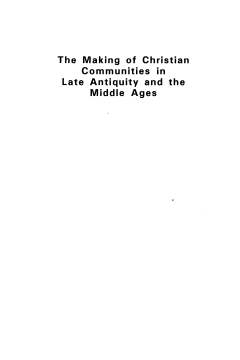
BOOK
The Making Of Christian Communities in Late Antiquity and the Middle Ages
(2004)
Additional Information
Book Details
Abstract
'The Making of Christian Communities' sheds light on one of the most crucial periods in the development of the Christian faith. It considers the development and spread of Christianity between Late Antiquity and the Middle Ages, and includes analysis of the formation and development of Christian communities in a variety of arenas, ranging from Late Roman Cappadocia and Constantinople to the court of Charlemagne and the twelfth-century province of Rheims, France during the twelfth century. The rise and development of Christianity in the Roman and Post-Roman world has been exhaustively studied on many different levels, political, legal, social, literary and religious. However, the basic question of how Christians of Late Antiquity and the Early Middle Ages formed themselves into communities of believers has sometimes been lost from sight. This volume explores the idea that survival of the Christian faith depended upon the making of these communities, of which the Christians of this period were themselves acutely – and sometimes acrimoniously – aware.
'The Making of Christian Communities' sheds light on one of the most crucial periods in the development of the Christian faith. It considers the development and spread of Christianity between Late Antiquity and the Middle Ages, and includes analysis of the formation and development of Christian communities in a variety of arenas, ranging from Late Roman Cappadocia and Constantinople to the court of Charlemagne and the twelfth-century province of Rheims, France during the twelfth century.
Mark F. Williams is Professor of Classics at Calvin College, Michigan, USA.
Table of Contents
| Section Title | Page | Action | Price |
|---|---|---|---|
| Front Matter | 1 | ||
| Half Title | 1 | ||
| Title | 3 | ||
| Copyright | 4 | ||
| Contributors | 5 | ||
| Contents | 7 | ||
| Preface, by Giles Constable | 9 | ||
| Main Matter | 12 | ||
| Introduction, by Mark Williams | 13 | ||
| Chapter 1: The Disruptive Impact of Christianity in Late Roman Cappadocia, by Raymond Van Dam | 19 | ||
| 1. New Patterns of Behavior | 21 | ||
| 2. New Histories | 27 | ||
| 3. Lost Histories | 31 | ||
| 4. Mosoch the Founder | 34 | ||
| Chapter 2: Constantinople: Christian City, Christian Landscape, by Oliver Nicholson | 39 | ||
| Chapter 3: Communities of the Living and the Dead in the Late Antiquity and the Early Medieval West, by Frederick S Paxton | 61 | ||
| Chapter 4: The Gothic Intellectual Community: The Theology of the Skeireins, by James W Marchand | 75 | ||
| Chapter 5: 'Seed-sowers of Peace': The Uses of Love and Friendship at Court and in the Kingdom of Charlemagne, by C Stephen Jaeger | 89 | ||
| Chapter 6: Scaldic Poetry and Early Christianity, by Asdis Egilsdottir | 105 | ||
| Chapter 7: Heloise and the Abbey of the Paraclete, by Chrysogonus Waddell | 115 | ||
| Chapter 8: Communities of Reform in the Province of Reims: The Benedictine 'Chapter General' of 1131, by E Rozanne Elder | 129 | ||
| Background | 130 | ||
| Present Questions | 132 | ||
| The Abbots | 133 | ||
| The Abbeys | 134 | ||
| Abbots by Rank | 134 | ||
| The Veteran Abbots | 135 | ||
| The Middlers | 135 | ||
| The Freshmen | 135 | ||
| The Latecomers | 136 | ||
| The Alumni | 136 | ||
| Conclusions | 139 | ||
| Chapter 9: When Jesus Did the Dishes: The Transformation of Late Medieval Spirituality, by Brian Patrick McGuire | 143 | ||
| St Joseph and his Family | 145 | ||
| Jean Gerson and the Renewal of Theological Discourse | 147 | ||
| Gerson's Josephina: A New Spiritual Hero | 151 | ||
| The Meaning of Gerson's Devotion to St Joseph | 160 | ||
| End Matter | 164 | ||
| Notes | 164 |
